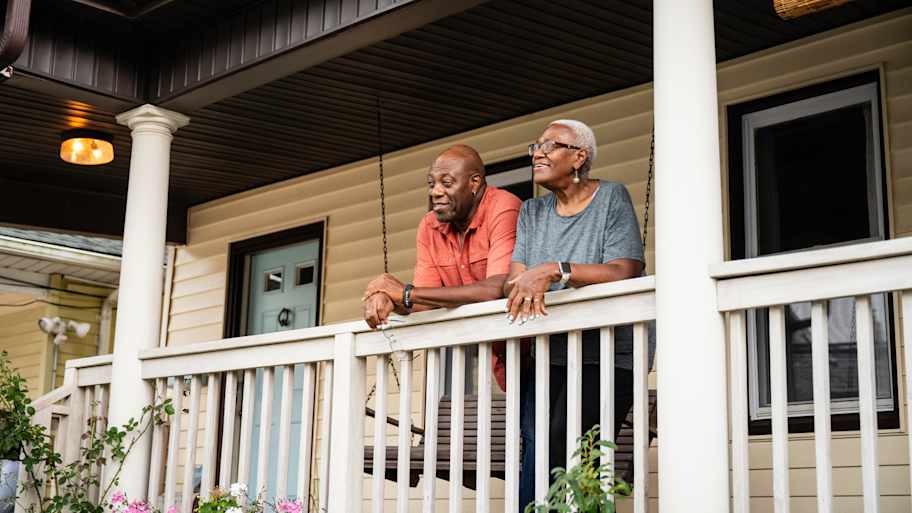Deck replacement costs depend on materials, any structural damage you need to fix, and more. This guide explores how much it costs to replace or repair a deck.

Get matched with top patio cover pros in your area
Enter your zip and get matched with up to 3 pros
Matching on Angi


Patio cover pros near you
Verified Reviews for Patio Cover Service pros in
*The Angi rating for Patio Cover Service companies in is a rating based on verified reviews from our community of homeowners who have used these pros to meet their Patio Cover Service needs.
*The HomeAdvisor rating for Patio Cover Service companies in is a rating based on verified reviews from our community of homeowners who have used these pros to meet their Patio Cover Service needs.
Last update on
Patio Cover Service FAQs
While the terms deck and porch are often used interchangeably, they are two distinct home features. Porches offer a roof that protects from the elements when coming and going from the house. Generally, porches are on the front of your home. On the other hand, decks are generally built in the backyard of a home and offer no roof or protection from the elements, like rain or snow. Porches typically require less maintenance and upkeep thanks to the roof, but both features require regular cleaning and repairs to maintain good condition.
The cost of an awning is $1,400 to $4,400 on average. However, this cost could be as low as $100 or as high as $7,500, depending on a few factors. The type of awning you choose, the size you need, and your location all affect your overall cost.
For example, portable awnings you can put up and take down yourself range from $100 to $400, whereas motorized awnings are more luxurious and cost between $2,000 and $3,500.
The cost to build a deck is $8,025 on average. However, this cost can range anywhere from $1,500 to $22,000, depending on multiple factors, such as size, materials, and deck type. You can expect to pay $30 to $60 per square foot when building a new deck.
Cedar decks are often the most cost-effective option, ranging from $4 to $9 per square foot for materials. However, pressure-treated decking, which is resistant to rot, is more expensive, ranging from $15 to $25 per square foot for materials.
Awnings are either fixed or retractable and can be paired with a variety of cover materials. Fixed awnings are a permanent outdoor feature of a building. These are highly durable and require ongoing maintenance. Once installed, the position of this awning cannot be changed.
Retractable awnings are more popular than fixed awnings since the cover can open and close. This allows homeowners to open and close the awning, depending on the weather. When not in use, it can be closed to allow for extra space.
Besides the type of awning, you’ll need to choose the type of cover. Your awning installation professional will review your options with you, including availability and costs. The types of covers you can choose from include:
Wood, which is durable but can be damaged easily by rainwater and fire
Cotton offers flexibility, weatherproofing, and easy cleaning
Canvas is highly durable and is a good choice for retractable awnings
Metal is sturdy but is prone to rust
Polyester is easy to clean and is a more breathable option
Polycarbonate is highly resistant to UV rays and is difficult to damage
The homeowners guide to patio cover services
From average costs to expert advice, get all the answers you need to get your job done.
 •
•Discover awning fabric replacement costs and learn about materials, labor, and additional factors to budget your awning upgrade with confidence.
 •
•Discover the true awning installation cost for your home. Learn about average prices, cost factors, and ways to save on your project.

A retractable patio awning creates a comfortable outdoor space that can insulate and protect your home. Here's a look at its pros and cons.

Install an awning like a pro with five simple steps: prep the site, get your numbers right, mark the mourning, install support, and finally, the awning.

Dreaming of an outdoor area for relaxation, but not sure how big to go? Learn about standard porch sizes and how to set proper dimensions.
- Tree Removal
- Window Cleaning
- Furniture Assembly
- Tree Trimming
- Snow Removal
- Vehicle Shipment
- Maid Service
- House Cleaning
- Lawn Mower Repair
- Gutter Repair
- Trampoline Assembly
- Appliance Removal
- Sink Installation
- Faucet Installation
- Cabinet Painting
- Plumbing
- Hvac Repairs
- Air Conditioning Repair
- Electrical
- Handyman Service
- Landscaping
- Furnace Repair
- Roofing
- Locksmiths
- Emergency Plumbers
- Hvac
- Lawn Care
- Moving Companies
- Septic Tank Repair
- Air Duct Cleaning